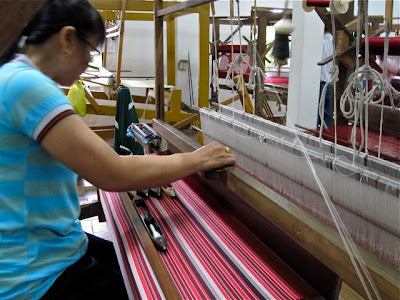

The weavers operating with their hand looms can only produce about two to three yards of Thai silk fabric in a single day even if they are very skilled and experienced in their craft.
HOW SILK IS MADE..
The process begins by raising silkworms. These silkworms feed and live on mulberry leaves. This process is called " SERICULTURE ". These silkworms are caterpillars not worms. When they mature, the silkworms spin silk cocoons.



The cocoons are then degummed by the weavers using special chemicals. There are 2 kinds of cocoons... the white and the yellow cocoons. The white cocoons are smooth and the yellow cocoons are short and rough.

They boil the degummed silk in various natural or chemical dyes, constantly stirring the silk in order to get uniform color. This unravels the thread and separates it from the caterpillar inside. The dyed silk thread is then dried.

The dried and dyed silk is then spun into yarn on wooden spindles. The Thai women use this yarn to spin the fabulous Thai silk.

This process is very time consuming but the final hand woven Thai silk fabric is a unique, high quality work of art by the Thai weavers. What I found out when I was in Luang Prabang Phnom weaving village was it would take one weaver at least 2 weeks just to make one scarf.
Here are some tips on THAI SILK.... I hope you can make use of these information...
HOW TO RECOGNIZE 100% PURE SILK...

** Pure silk costs 10 times as much as imitation silk.
** Pure Thai Silk weave is completely handmade and it is made of natural fiber with clearly visible small flaws on the fabric. Imitation silk that is made from polyester is machine made and almost always has no flaws in the fabric.
** Check the luster of the material. Pure Thai silk is made of one color for the wept and one color for the warp. This produces the sheen and luster of the material thus creating the unique two tones and blends which change depending on the angle of the light. Imitation polyester silk shines regardless of angle of light.
** If you burn Thai silk with a lighter, it leaves a fine ash and smells like burning hair. If you burn imitation silk --- it drips and burns with a black smoke and continues to burn even if you take away the flame.
HOW TO REMOVE WATER STAINS IN SILK
** Fill the sink with warm water. Be sure that the water is warm and not hot as too much heat can damage the silk.
** Plunge the garment into the water several times to make sure that the garment gets wet.
** Place the garment on a dry clean towel. DO NOT WRING it out.
** Place another towel on top of it and press gently to take out any moisture left on the garment.
** Set the garment in a cool dry place. Do not put it under direct sunlight.
** When the garment is dry, place a clean cloth over the stained area and iron over it gently on LOW SETTING.
ENJOY YOUR SILK GARMENT !!!!




No comments:
Post a Comment